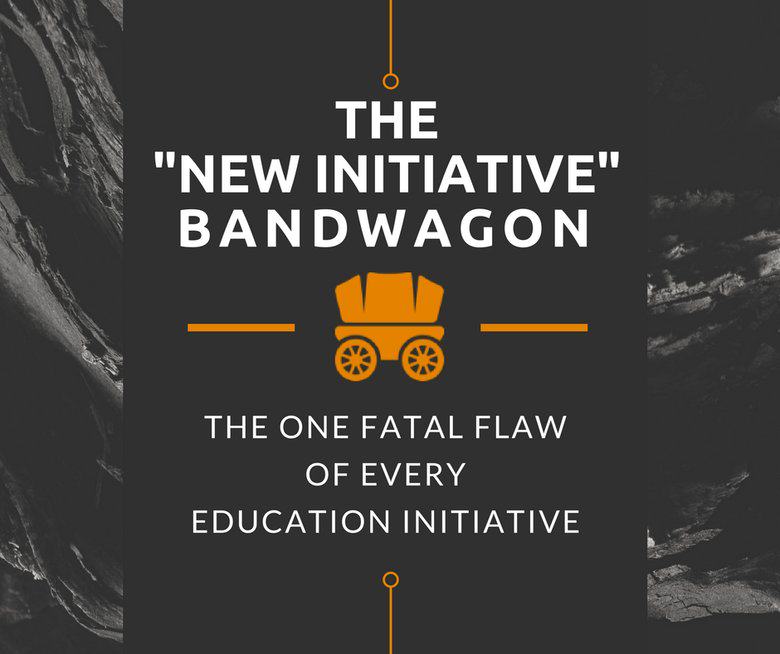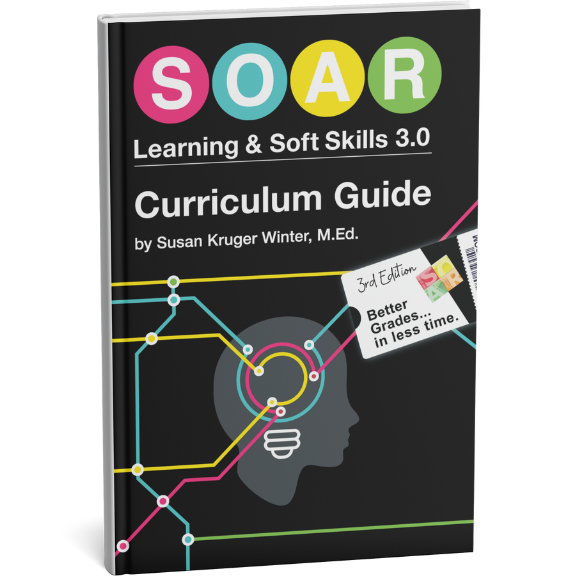The “New Initiative” Bandwagon:
The One Fatal Flaw of Every Education Initiative
Why Do You Have to Work So Hard to Make Students Learn?
You work harder and harder, but clearly feel a drag. You are tasked with more things to do, document, and correlate every day. Your extended efforts never seem to be enough. Students become more apathetic.
Many people are quick to blame technology. But, that’s not it. There is something much more significant going on.

“New initiatives” only address 50% of the equation; they only provide perspectives and tools for TEACHERS to deliver content. They do not teach STUDENTS how to learn or process that content.
The “New Initiative Bandwagon”
In an effort to “fix” the problem, politicians and school systems usher in new “initiatives” to improve instruction and finally make things better. These initiatives are mapped together with new curriculum standards so that you can have “air-tight” plans when you enter the classroom.
The initiatives revolve in cycles, usually every 1-3 years. You and your colleagues roll your eyes as the new one marches in. You know that This Year’s Initiative is the same as Last Year’s Initiative; the only difference is the language.
These initiatives are named with various proper and common nouns. Some “classics” include Maslow’s Hierarchy and Bloom’s Taxonomy. More recent evolutions include VAK (visual, auditory, kinesthetic) and Marzano’s Nine Essential Instructional Strategies.
Why These Initiatives Don’t Work…
There is nothing inherently wrong with any of these theories or strategies; I use most of them to create lessons and curriculum, myself.
At best, however, they only address 50% of the equation! They only provide perspectives and tools for you, as the teacher, to deliver content.
They do not teach students how to process that content: how to consume it, analyze it, ask questions, or make decisions about it.
For example…
Maslow tells us that our students need to have their basic needs met in order to be in the “green zone” of learning. This is vital for teachers to know. But, do we teach students how to deal with physical and emotional challenges that keep them from reaching their optimal state of learning?
Bloom taught us to recognize different levels of learning. But, do students know about these different levels… let alone how to get into “high gear” learning?
Visual, Auditory, & Kinesthetic Learning Styles (VAK) are important for us, as teachers, to understand; we must be able to provide instruction and assessments in a variety of modalities. However, VAK only confuses students; they can identify their preferred learning styles, but there is very little they can do about it. They have no control over the assignments and tests they are required to do.
Marzano’s Nine Essential Instructional Strategies are filled with great strategies for teachers, such as encouraging teachers to use “nonlinguistic representations” (otherwise known as “symbols”) to represent relationships.
But, students should be taught that visuals are very powerful for the brain! They should be coached to create their own visuals, instead of always having visuals presented TO them.
Otherwise, they are simply memorizing symbols (low-gear learning) instead of creating their own associations (high-gear learning).
You Are Fighting Gravity!
You are swamped with strategies detailing what YOU should do. This is nothing but overwhelming. Every day, you try to do better, but you keep feeling less effective.
Is it any wonder?
Everything you’ve have been taught –every college class, PD session, and magazine article– suggests that YOU do all of the work. Meanwhile, students are only learning how to follow directions by: memorizing visuals, filling in the blanks on graphic organizers, and answering questions instead of creating them.
The Other 50% of the Equation
You will always feel like you are slugging uphill until your students learn the strategy for learning. Strategic learning skills are the great differentiator because they put students in the driver’s seat. They teach students how to learn; how to ask questions and navigate their way with high-level skills.
Strategic learning skills teach students how to: think forward and set their own goals, create their own purpose for learning, organize their papers and supplies, learn strategically, & monitor their progress along the way.
Notice that none of these skills are about YOU doing more work.
It is time for STUDENTS to carry the weight of their own success! The best part is they WANT this responsibility; they thrive on a good challenge and would love to be woken from their educational coma!
With strategic learning skills, they will have the tools to meet these challenges effectively and you will stop fighting gravity. Instead, you will become the encouraging coach and facilitator you envisioned when you chose this profession. It’s a win-win for everyone!
SOAR® has always been focused on empowering students with these skills:
- SOAR® is proven to raise students GPAs by an average of one full point! (Details here.)
- SOAR® covers 100% of the Common Core College and Career Readiness Anchor Standards!
- Students literally beg for SOAR®! They know that they don’t know how to learn… and they want to! See a true story about students begging their administration for SOAR® here.
Will you be the hero for your school, empowering your students and saving your coworkers sanity by providing the other 50% of the equation?
To our students’ success,
Susan Kruger Winter, M.Ed.
EB 050217
Six Steps
Conquer the Chaos
Get Our Free Guide & Information on...
 How to Organize & Motivate Students for Success
How to Organize & Motivate Students for Success
"*" indicates required fields
Get Our FREE Curriculum Guide!
The SOAR® Curriculum
The most critical learning, organizing, and communication skills needed for school. Learn more here.
Who’s Using SOAR®?
SOAR® Guarantee
Click here to learn more.





